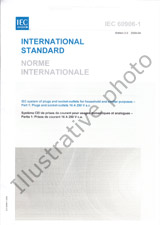We need your consent to use the individual data so that you can see information about your interests, among other things. Click "OK" to give your consent.

IEC 60990-ed.3.0-RLV
Methods of measurement of touch current and protective conductor current
Translate name
STANDARD published on 30.5.2016
The information about the standard:
Designation standards: IEC 60990-ed.3.0-RLV
Publication date standards: 30.5.2016
SKU: NS-1095151
The number of pages: 191
Approximate weight : 604 g (1.33 lbs)
Country: International technical standard
Category: Technical standards IEC
The category - similar standards:
Other standards related to electricity and magnetismInformation technology (IT) in general
Annotation of standard text IEC 60990-ed.3.0-RLV :
IEC 60990:2016 RLV contains both the official IEC International Standard and its Redline version. The Redline version is available in English only and provides you with a quick and easy way to compare all the changes between the official IEC Standard and its previous edition. IEC 60990:2016 defines measurement methods for d.c. or a.c. current of sinusoidal or non-sinusoidal waveform, which could flow through the human body, and current flowing through a protective conductor. The measuring methods recommended for TOUCH CURRENT are based upon the possible effects of current flowing through a human body. In this standard, measurements of current through networks representing the impedance of the human body are referred to as measurements of TOUCH CURRENT. These networks are not necessarily valid for the bodies of animals. The specification or implication of specific limit values is not within the scope of this standard. IEC TS 60479 series provides information regarding the effects of current passing through the human body from which limit values may be derived. This standard is applicable to all classes of EQUIPMENT, according to IEC 61140. The methods of measurement in this standard are not intended to be used for TOUCH CURRENTS having less than 1 s duration, patient currents as defined in IEC 60601-1, a.c. at frequencies below 15 Hz, and currents above those chosen for ELECTRIC BURN limits. This third edition cancels and replaces the second edition published in 1999. It constitutes a technical revision. The principal changes in this edition as compared with the second edition are as follows: - the effects names have been updated to reflect increased understanding of the range of effects and is in concert with present usage; - the conditions of use invoking a GRIPPABLE PART have been reduced in the application of the requirements based upon the current understanding of this effect; - the references to ISO 10012-1, which has been replaced by management standard of the same number, have been replaced with explanatory text, where needed to maintain the sense of the document; - former informative Annex H (GRIPPABLE PART) has been deleted from this update as it does not properly represent the full set of conditions under which immobilization can occur. A new informative Annex H (Analysis of frequency filtered touch current circuits measurement) has been added and the Bibliography (formerly Annex M) has been updated with additional references for completeness. This basic safety publication is primarily intended for use by technical committees in the preparation of standards in accordance with the principles laid down in IEC Guide 104 and ISO/IEC Guide 51. It is not intended for use by manufacturers or certification bodies independent of product standards. It has the status of a Basic Safety Publication in accordance with IEC Guide 104. Keywords: Touch Current, Protective Conductor Current, Current Flow
We recommend:
Technical standards updating
Do you want to make sure you use only the valid technical standards?
We can offer you a solution which will provide you a monthly overview concerning the updating of standards which you use.
Would you like to know more? Look at this page.



 Cookies
Cookies
